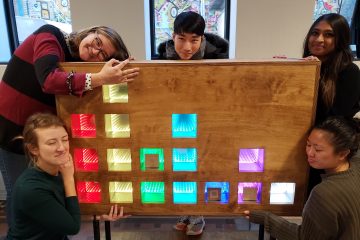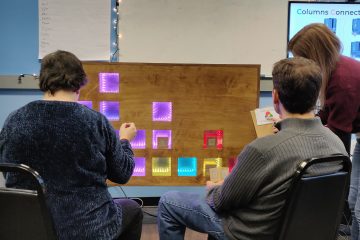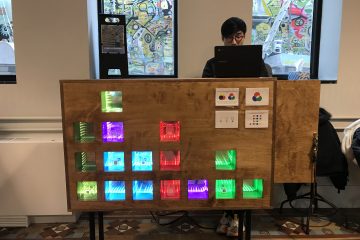Week 4
We had playtesting at the end of Week 3 that lead us to make a few very helpful design decisions. We decided to move forward with boxes containing passive RFIDs that we put into a grid/shelf system that reacts. Although, we still feel very strongly about the original Sensory Blocks concept, we did not feel confident that we would be able to figure out a stable power supply.
Playtesting revealed that players were always attracted to the boxes that they were able to pick up and hold (the third option from Week 3 blog).

They give the guests more agency over what they are doing and the decisions they are making. The other two options were either too boring or not robust enough. Now it was our challenge to work on some interesting interactions that accomplished a few goals:
- Exciting for all personality types: want to engage all types of museum goers! Ones who are looking to solve for something, create something, as well as those passively engaging.
- Since our target audience are aged 10+ we want to work on creating something that gets them experimenting, but maybe disguise it as fun!
- Interest, Mastery, Curiosity! We keep revisiting these pillars when we think about design. Do our interactions foster interest, mastery and curiosity for our guests?
We began working on developing interactions for the experience. We were inspired by the modern takes on classic artwork in the space.You can spot Nidhi and Wei posing in front of the Neil Mendoza interactive art pieces located in the Tech Lab.
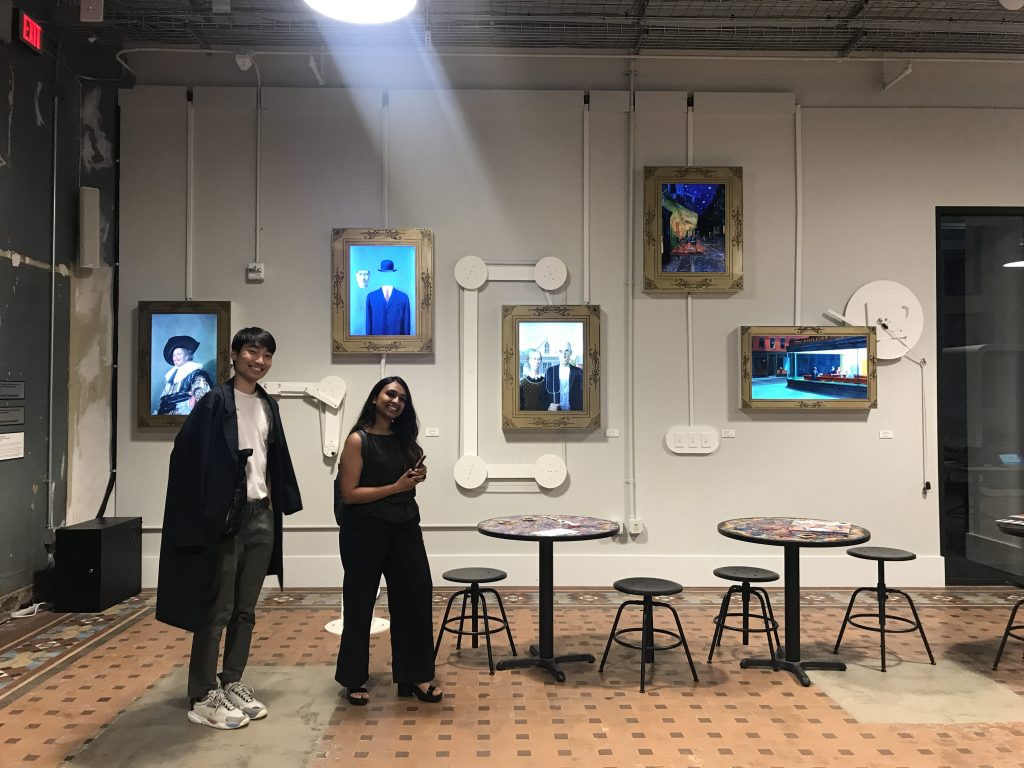
This twist on modern art aesthetic got us thinking about Mondrian and using colored boxes as a core part of our interaction. Daryl designed a Mondrian inspired layout and interactions.
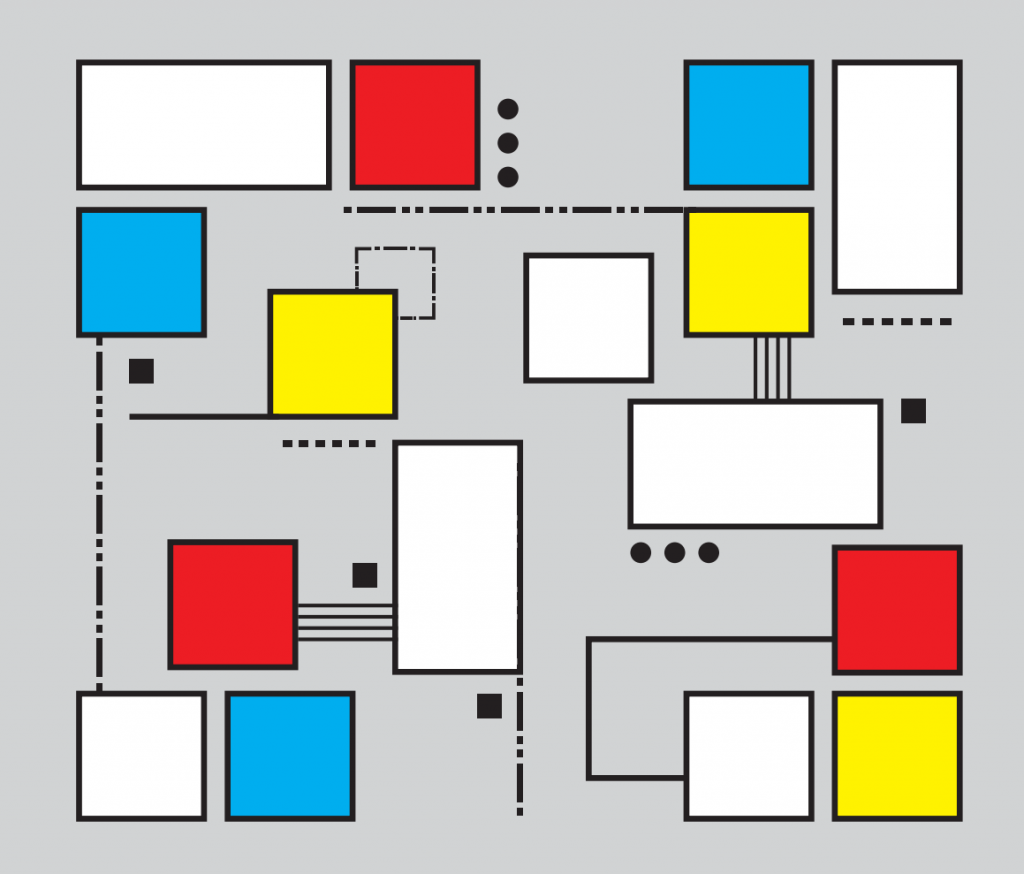
The first iteration of interactions was inspired by the RGB color spectrum. LED lights/digital lights are displayed in an RGB color spectrum. This is as a result of the properties of the bulbs. CMYK color spectrums are used for printing and are the most familiar to students as they represent typical color mixing; red and yellow make orange, yellow and blue make green. BUT RGB color spectrum has different “rules,” most notably the weirdest one is that red and green make yellow.
While CMYK color spectrum is taught from an early age in art classes, RGB is not typically covered unless students are learning about HTML/CSS coding. RGB color spectrum is used in designing websites to code the colors of the site.
In the museum, there are a lot of color mixing experiences, but RGB is the next level up that is not covered. In this iteration we created the following logic for the experience:
- There are three types of blocks: Red, Green, and Blue.
- There are 5 types of cubbies: Single – neutral, Single – red, Single – green, Single – blue, and dual – neutral.
- The dual cubby allows two blocks to be placed in and the cubby changes color to the mixing of the two.
- The single – neutral takes on the color of the block that is placed in.
- The single – colored cubbies mix with the color cube that is provided.
We wanted to have students ask questions and try to figure out the logic of the world. Again, we’re aiming to promote curiosity through play. We were having a hard time explaining this concept, so Nidhi had the brilliant idea to create a VR prototype to both explain and playtest our interactions. See a video below that contains a rough mockup of our installation. The colored cubbies represent LED light colors that would change.
This week, we had quarter walkarounds. Here was some of the feedback that we received:
- Hard age group
- 10-14 y.o. Care about mastery and expression- give them depth
- What’s the logic?
- What’s the question at the beginning? What gets you started?
- Need a prompt– would add a lot to guest experience
- Like idea of exploring and understanding rules
- Are there levels?– Can you use the knowledge you gain to solve the levels?
- Surprises?– Use box to do something someone doesn’t know will happen?
- Encourage puzzle solving and expression
- Like where idea is starting- needs more at end
- Needs reward element
- Could it be a 2 phase experience- way to program puzzle and solve puzzle
- Expected time of engagement?
- Simplify to execute and learn in certain amount of time
- More layered the experience, the more the guests pullout from it, the kids engage, and connections get made
- Don’t want kids to master once and done
- What makes me want to come back and do it again? If we want replayability– external ability to reset palette
- What is the color palette?
- Ask educators- what color wheel are students taught when? Maybe learn light palette in science?
- Player Experience?
- How many people play at a time?
- Idea is play and whatever that means/ what that looks like
- Want to have balance between play and purpose and achievement–discovery moment
- Love metaphor of hidden universe to discover– feels science related
- Right now it seems like very little opportunity for expression
- Danger is expression and exploration seem to be goals that counter each other
- What’s the magic and the motivation?
- What is the cool?
- Be Braver!
- Installation:
- Would the blocks walk off?
- Ambient experience/impressiveness of that is component to be considered
- One way to ramp up/escalate experience is to make it bigger ~1000 boxes?
- Concern about movability– adds to complexity
- Theme the installation appropriately- added layer to experience and to keep tech away
- Consider lighting in space
On Friday, we had a group of high school students (9th graders) come to visit our room. We asked them questions about what they would want to see in a museum experience, we playtested the paper prototype, and we playtested the VR experience with all the students. We had about 24 students playtest our experience.
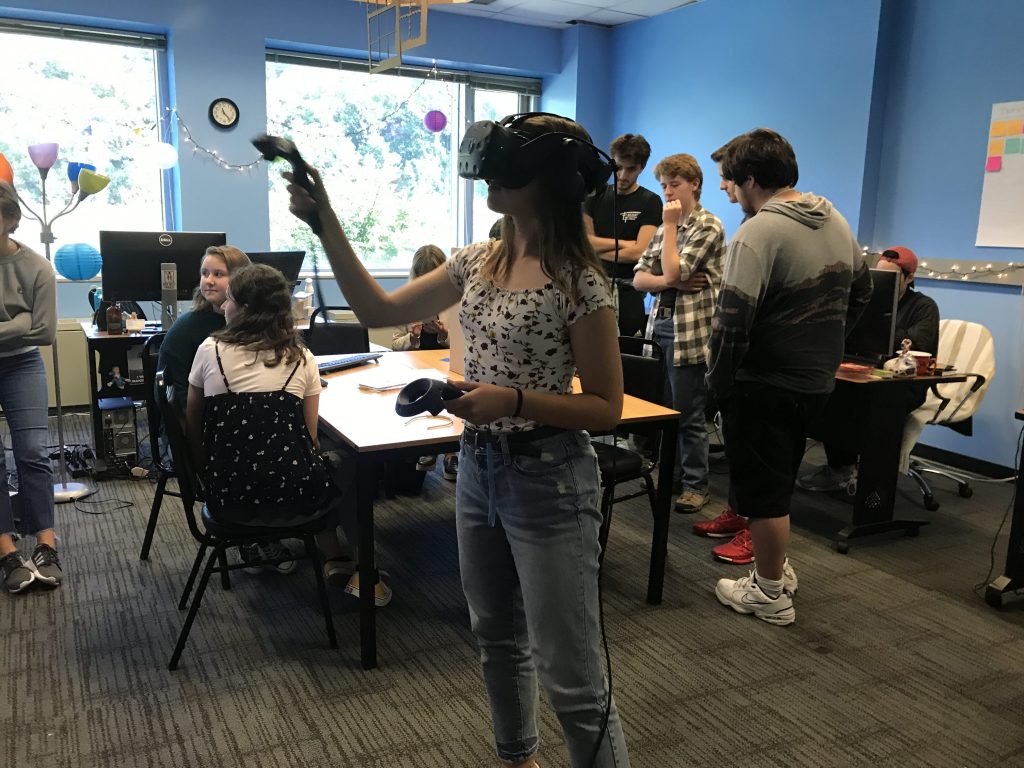
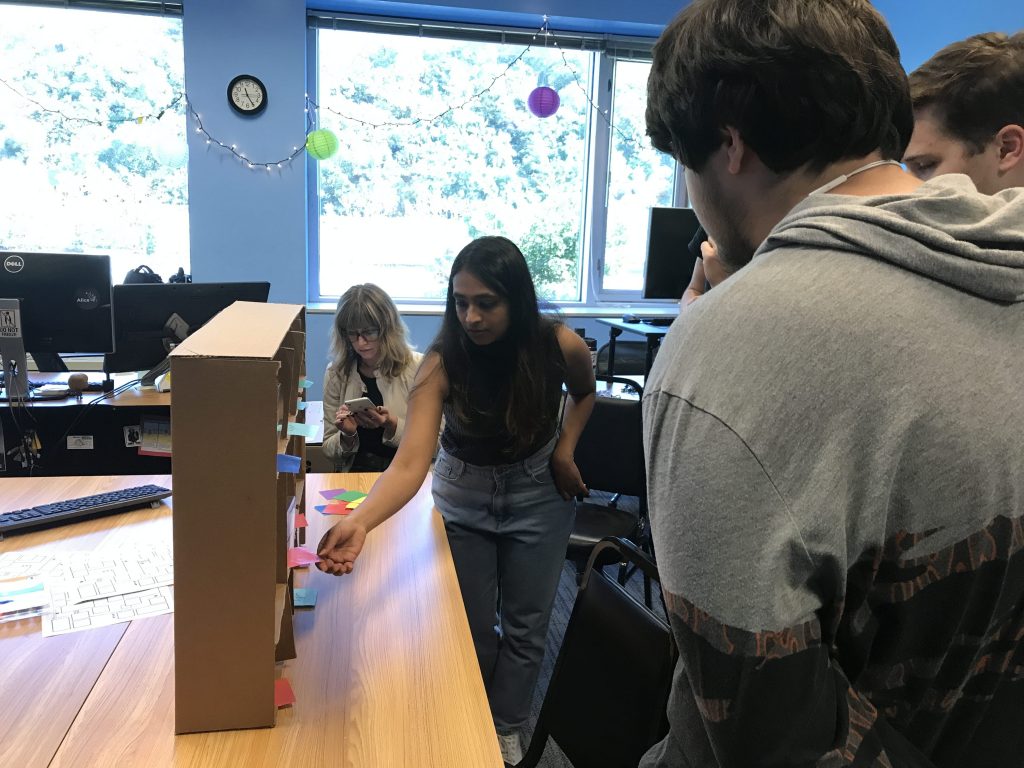
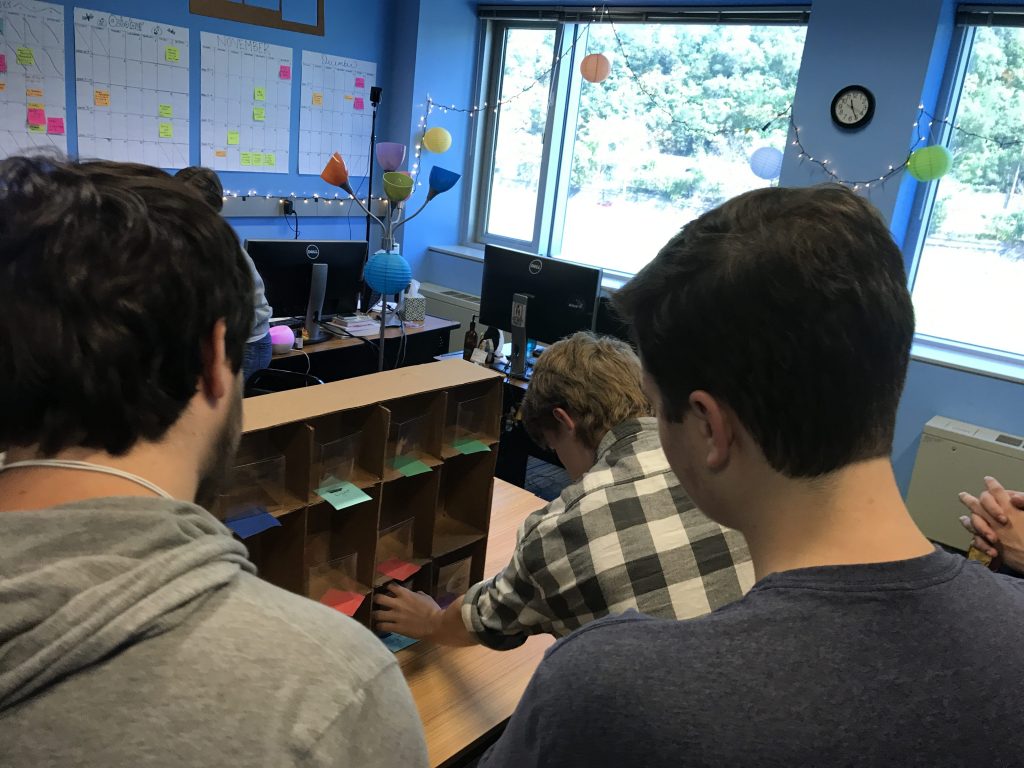
From the playtest we learned:
- No students were able to determine the RGB logic
- Too many variables involved – not knowing the nature of the cube or the nature of cubbies
- Knew there was a logic and tried to figure it out using scientific method – got really close!
- Wanted to be able to change all the blocks to a specific color, were frustrated when they were limited
So for the next playtest we will:
- Simplify number of variables: only unknown variable is the property of the blocks, the wall reacts to the box’s properties
- Try new logic: will an HSL spectrum be more intuitive than RGB?
- Do they figure it out?
- Are they able to use logic to be expressive?
- Determine are guests engaged?
- What is the pattern of play?
- Do we see thoughtful placement?
- Do we see random placement?
- Length of engagement?
- What is the pattern of play?
- Do guests want a goal?
- What do guests expect?
- What are guests trying to do?
- What do guests want to do?
For Quarter Sitdowns, Jon Dessler and Shirley Saldamarco stopped by. They were happy that we were able to playtest in the morning and address some of the concerns from walkarounds. They provided us with the following advice/questions:
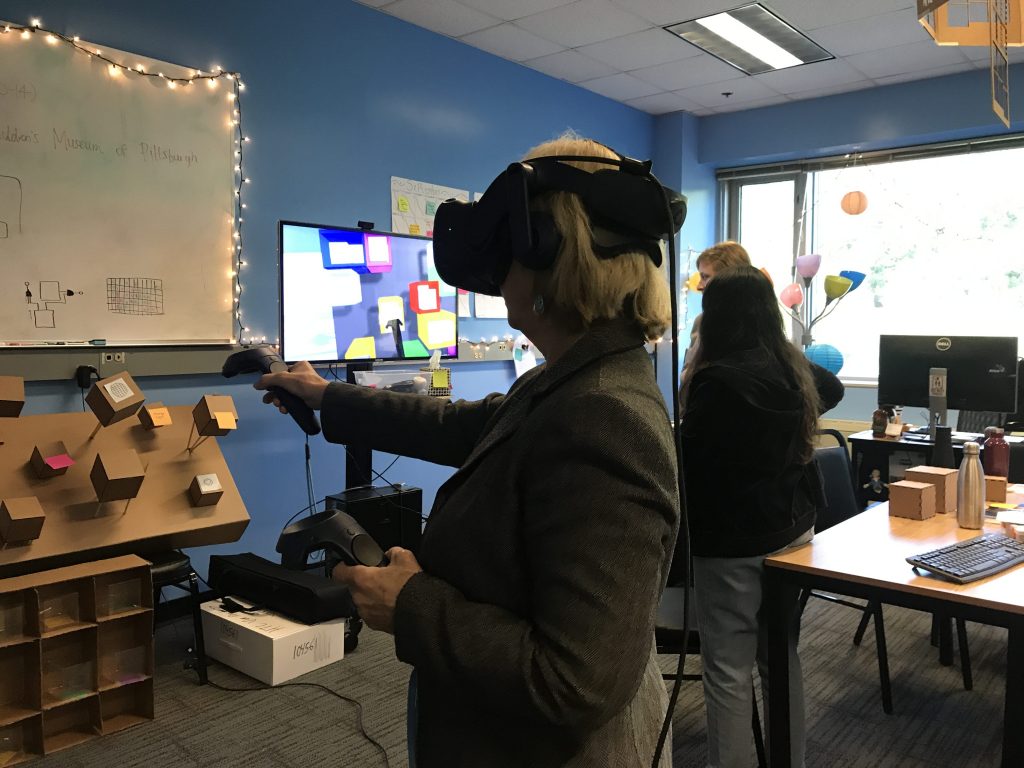
Jon Dessler
- Playtesting! – what is cool to middle schoolers?
- Length of engagement?
- Type of users
- Best case scenario?
- Worst?
- Min? Max?
- Time length
- Type of users
- Get guest into creative process
- Doesn’t matter if they connect to RGB – should figure out after
- Want freedom to decide how to play?
- Layer of their world? Their rules?
- How do I identify my own cubes?
- Understand middle school brain
- Learn how world operates → creative
Shirley
- Interest level?
- Waves?
- Length of engagement?
We learned alot this week and got helpful feedback from faculty. Our next steps will be:
- Getting into the minds of middle school students – interviewing middle schoolers and teachers! Getting to know our demographic.
- Developing and testing new interactions
- Supplies! Now that we know what we’re building, we’ve got to develop a material list, budget, and order all of the equipment we need.
- Hardware! Now… how do we actually bring this idea to life?
